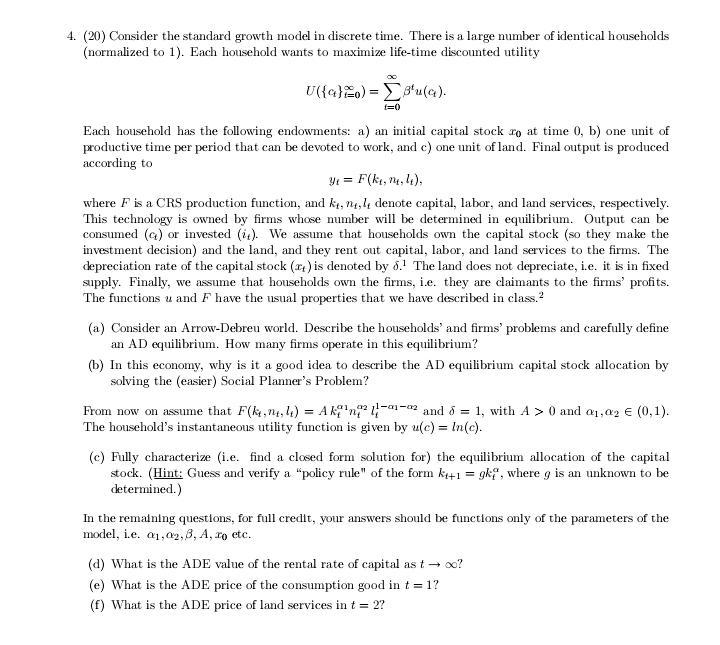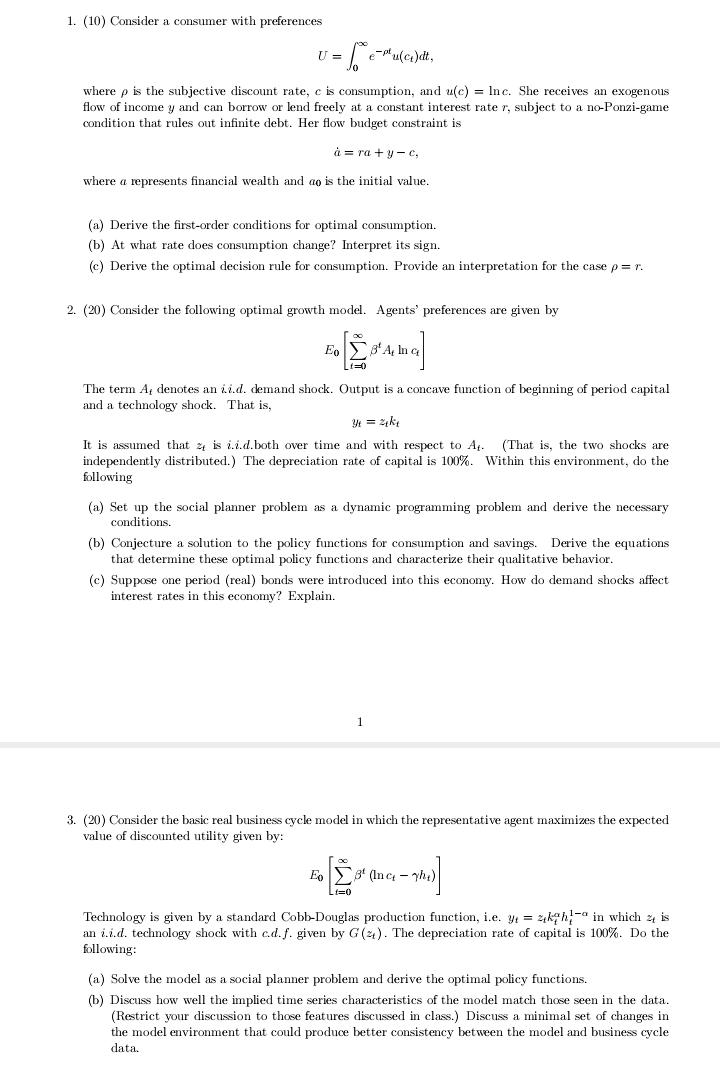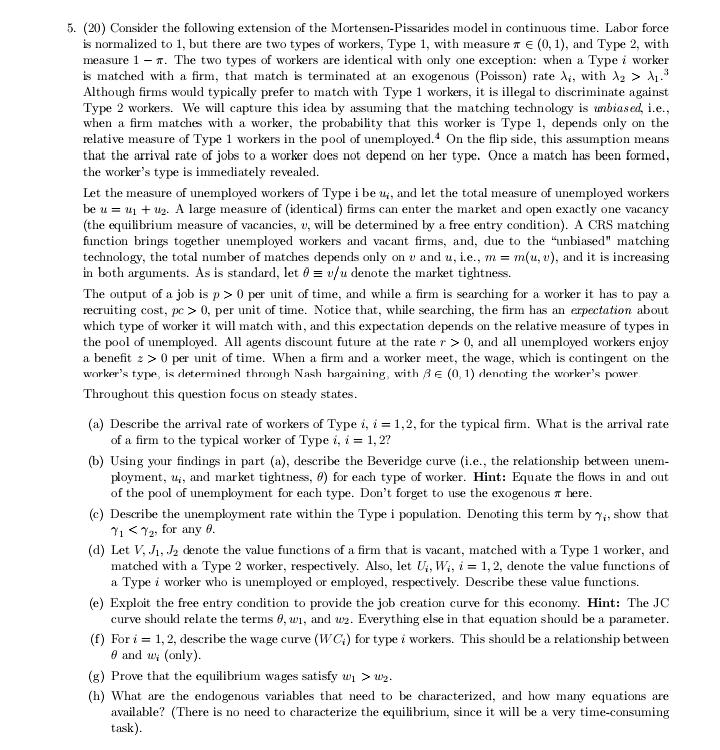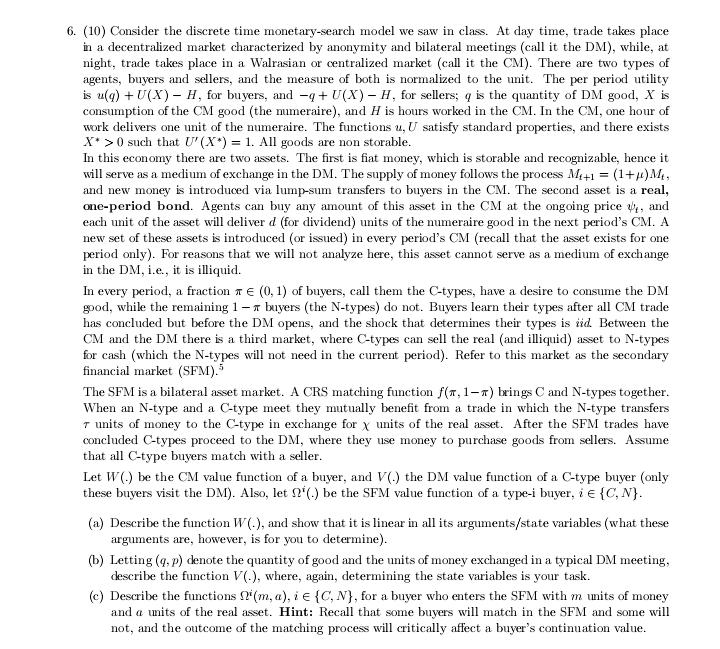
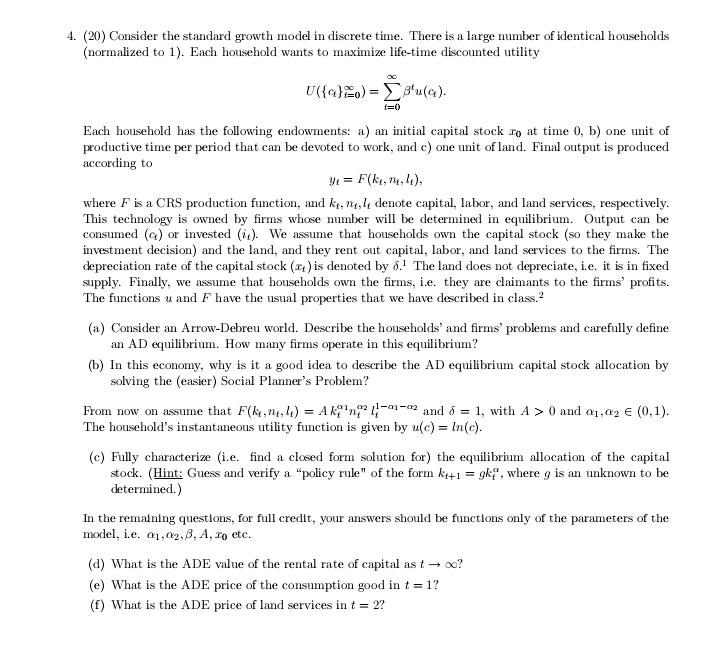
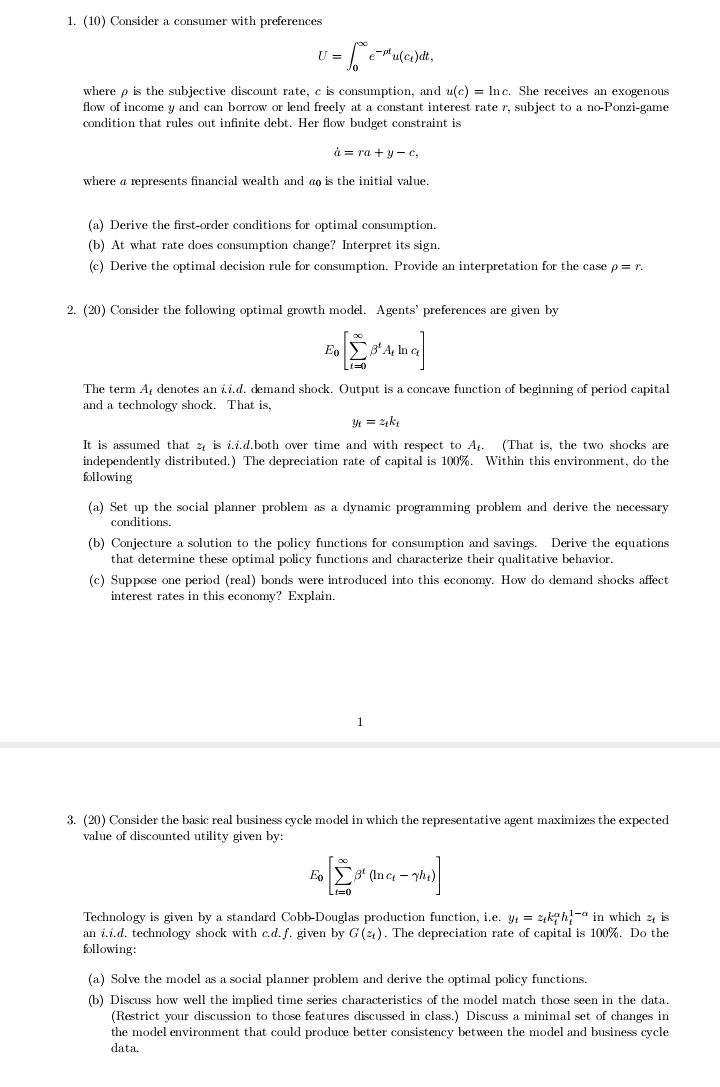
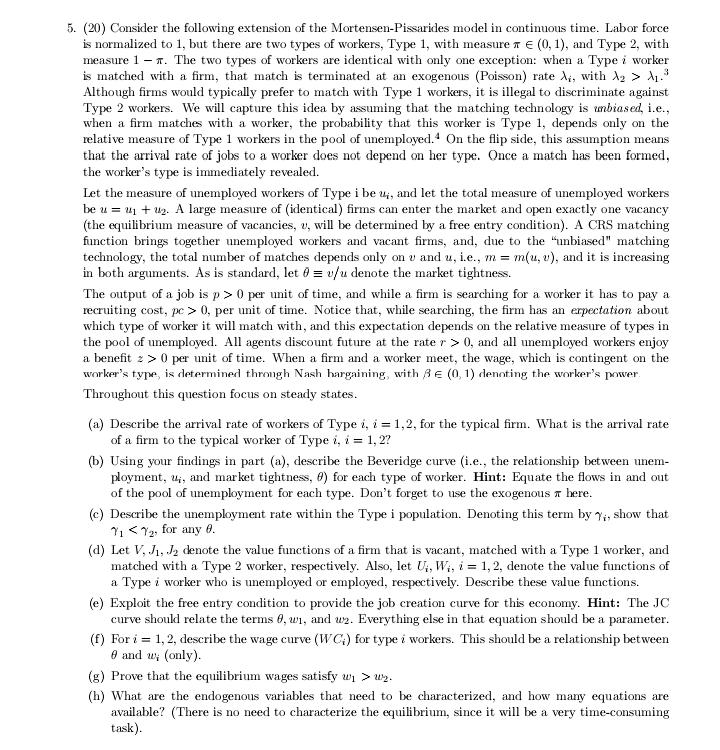
EXplain each..::
. {11]} Consider the discrete time monetary-search model we saw in class. At day time, trade takes place ii a decentralized market characterized by anonymity and bilateral meetings {call it the DM}, while, at night, trade takes place in a Walrasian or centralised market {call it the CM}. There are two types of agents, buyers and sellers, and the measure of both is normalized to the unit. The per period utility 'B uliq} + Hut} H, for buyers, and q+ ULX} H, for sellers; 4} is the quantity of DM good, I '3 consumption ofthe CM good {the mu'neraire}, and H is hours worlmd in the CM. In the CM, one hour of nork delivers one unit of the nm'ueraire. The functions u, U satisfy standard properties, and there exists X\" :2- G such that U'I[X"} = 1. All goods are non storable. In this economy there are two assets. The rst is at money, which is storable and recognizable, hence it will serve as a medim'n ofexchange in the UM. The supply ofmoney follows the process M,\" = {1+p}M1, and new money '3 introduced via lump-stun transfers to buyers in the CM. The second asset is a real, ale-period bond. Agents can buy any amount of this asset in the GM at the ongoing price up\" and each unit of the asset will deliver I! [for dividend} units of the numeraire good in the next period's CM. A new set of these assets is introduced {or iEue-d} in every period's CM {recall that the HEEL exists for one period only}. For reasons that we will not analyze here, this asset cannot serve as ame-dimn of exchange in the DM, i.e., it is illiquid. In every period, a fraction 11' E {I}, 1} of buyers, call them the Ctyp-es, have a desire to consume the DM good, while the remaining 1 11' lzuyers [the Ntypes} do not. Buyers learn their types after all GM trade has concluded but before the DM opens, and the shock that determines their types is it'd. Between the CM and the DM there is a third market, where Ctypes can sell the real {and illiquid} asset to N-types for cash {which the Ntypes will not need in the current period}. Refer to this market as the secondary nancial market {SFM}.5 The SEM is a bilateral aaet market. A CHE matching function III-rt, 111} ll'ingsC and Ntypes together. 1'..i"|.?hen an N-type and a {Jtype meet they mutually benet from a trade in which the N-type transfers 1' units ofmoney to the Ctype in exchange for x units ofthe real aaet. After the seat trades have concluded Ctypes proceed to the DM, where they use money to purchase goods from sellers. Assmne that all Ctype buyers match with a seller. Let WIT.) he the CM value mction ofa buyer, and FL} the DM value function ofa Ctype buyer [only these buyers visit the DEL-'1}. Also, let {PL} be the SFM value function of a type-i buyer, i E {(3, N}. {a} Describe the flmction W[.}, and show that it is linear in all its argumentsfstate variables {what these arguments are, however, is for you to determine}. {b} Letting (q, 3:} denote the quantity of good and the units ofmoney exchanged in a typical DM meeting, describe the function FL}, where, again, determining the state variables is your task. {c} Describe the flmctions (Fist, 0.}, i E {C, N}, for abuyer who alters the SFM with m. units of money and a units of the real asset. Hint: Recall that same buyers will match in the SFM and some will not, and the outcome of the matching procea will critically affect a buyer's continuation value. 4. (20) Consider the standard growth model in discrete time. There is a large number of identical households (normalized to 1). Each household wants to maximize life-time discounted utility U(also) = >Bu(q). Each household has the following endowments: a) an initial capital stock ro at time 0, b) one unit of productive time per period that can be devoted to work, and c) one unit of land. Final output is produced according to 1 = F( k, m, !). where F is a CRS production function, and ky, m,, denote capital, labor, and land services, respectively. This technology is owned by firms whose number will be determined in equilibrium. Output can be consumed (q) or invested (i,). We assume that households own the capital stock (so they make the investment decision) and the land, and they rent out capital, labor, and land services to the firms. The depreciation rate of the capital stock (ry ) is denoted by 6. The land does not depreciate, i.e. it is in fixed supply. Finally, we assume that households own the firms, i.e. they are claimants to the firms' profits. The functions u and F have the usual properties that we have described in class.' (a) Consider an Arrow-Debreu world. Describe the households' and firms' problems and carefully define an AD equilibrium. How many firms operate in this equilibrium? (b) In this economy, why is it a good idea to describe the AD equilibrium capital stock allocation by solving the (easier) Social Planner's Problem? From now on assume that F(4, m, ),) = Atfin,? 170-2 and 5 = 1, with A > 0 and 01,02 6 (0,1). The household's instantaneous utility function is given by u(c) = In(c). (c) Fully characterize (i.e. find a closed form solution for) the equilibrium allocation of the capital stock. (Hint: Guess and verify a "policy rule" of the form kit 1 = gay, where g is an unknown to be determined.) In the remaining questions, for full credit, your answers should be functions only of the parameters of the model, i.e. 01, 02, 8, A, ro etc. (d) What is the ADE value of the rental rate of capital as t - co? (e) What is the ADE price of the consumption good in t = 17 (f) What is the ADE price of land services in t = 2?1. (10) Consider a consumer with preferences U = e -mu( coldt, where p is the subjective discount rate, c is consumption, and u(c) = Inc. She receives an exogenous flow of income y and can borrow or lend freely at a constant interest rate r, subject to a no-Ponzi-game condition that rules out infinite debt. Her flow budget constraint is a = raty - c. where a represents financial wealth and go is the initial value. (a) Derive the first-order conditions for optimal consumption. (b) At what rate does consumption change? Interpret its sign. (c) Derive the optimal decision rule for consumption. Provide an interpretation for the case p = r. 2. (20) Consider the following optimal growth model. Agents' preferences are given by The term A, denotes an i.d. demand shock. Output is a concave function of beginning of period capital and a technology shock. That is, It is assumed that & is did.both over time and with respect to At. (That is, the two shocks are independently distributed.) The depreciation rate of capital is 100. Within this environment, do the following (a) Set up the social planner problem as a dynamic programming problem and derive the necessary conditions. (b) Conjecture a solution to the policy functions for consumption and savings. Derive the equations that determine these optimal policy functions and characterize their qualitative behavior. (c) Suppose one period (real) bonds were introduced into this economy. How do demand shocks affect interest rates in this economy? Explain. 3. (20) Consider the basic real business cycle model in which the representative agent maximizes the expected value of discounted utility given by: Technology is given by a standard Cobb-Douglas production function, i.e. y, = 2kph, -" in which & is an Li.d. technology shock with ed. f. given by G (2). The depreciation rate of capital is 100%. Do the following: (a) Solve the model as a social planner problem and derive the optimal policy functions. (b) Discuss how well the implied time series characteristics of the model match those seen in the data. (Restrict your discussion to those features discussed in class.) Discuss a minimal set of changes in the model environment that could produce better consistency between the model and business cycle data.5. (20) Consider the following extension of the Mortensen-Pissarides model in continuous time. Labor force is normalized to 1, but there are two types of workers, Type 1, with measure * 6 (0, 1), and Type 2, with measure 1 - *. The two types of workers are identical with only one exception: when a Type i worker is matched with a firm, that match is terminated at an exogenous (Poisson) rate A, with A, > Al. Although firms would typically prefer to match with Type 1 workers, it is illegal to discriminate against Type 2 workers. We will capture this idea by assuming that the matching technology is unbiased, i.e., when a firm matches with a worker, the probability that this worker is Type 1, depends only on the relative measure of Type 1 workers in the pool of unemployed.' On the flip side, this assumption means that the arrival rate of jobs to a worker does not depend on her type. Once a match has been formed, the worker's type is immediately revealed. Let the measure of unemployed workers of Type i be wi, and let the total measure of unemployed workers be u = uj + u2. A large measure of (identical) firms can enter the market and open exactly one vacancy (the equilibrium measure of vacancies, v, will be determined by a free entry condition). A CRS matching function brings together unemployed workers and vacant firms, and, due to the "unbiased" matching technology, the total number of matches depends only on v and u, i.e., m = m(u, v), and it is increasing in both arguments. As is standard, let o = o/u denote the market tightness. The output of a job is p > 0 per unit of time, and while a firm is searching for a worker it has to pay a recruiting cost, pe > 0, per unit of time. Notice that, while searching, the firm has an expectation about which type of worker it will match with, and this expectation depends on the relative measure of types in the pool of unemployed. All agents discount future at the rate r > 0, and all unemployed workers enjoy a benefit = > 0 per unit of time. When a firm and a worker meet, the wage, which is contingent on the worker's type, is determined through Nash bargaining, with Ae (0, 1) denoting the worker's power Throughout this question focus on steady states. (a) Describe the arrival rate of workers of Type i, i = 1,2, for the typical firm. What is the arrival rate of a firm to the typical worker of Type , i = 1, 27 (b) Using your findings in part (a), describe the Beveridge curve (i.e., the relationship between unem- ployment, w, and market tightness, @) for each type of worker. Hint: Equate the flows in and out of the pool of unemployment for each type. Don't forget to use the exogenous a here. (c) Describe the unemployment rate within the Type i population. Denoting this term by y;, show that 71 we. (h) What are the endogenous variables that need to be characterized, and how many equations are available? (There is no need to characterize the equilibrium, since it will be a very time-consuming task)





